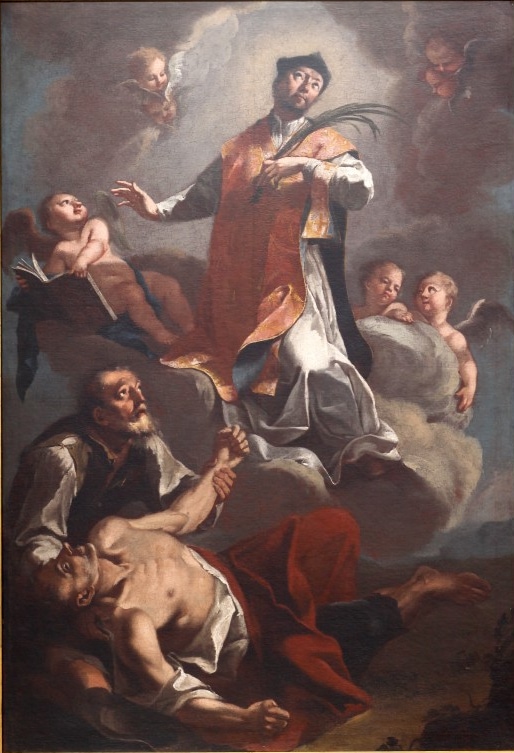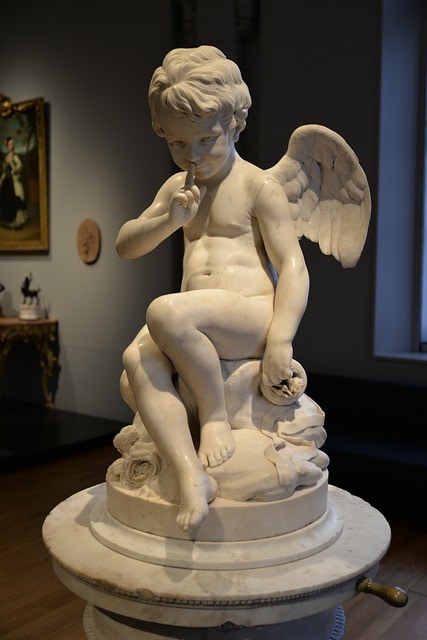
Table of Contents
Every February 14th is Valentine’s Day, and people celebrate it worldwide by exchanging gifts, such as greeting cards (best-known as valentines) or chocolates with their significant others, and sometimes even with their friends.
Some historians argue that the origins of Valentine’s Day are connected to the Roman pagan festival of Lupercalia. In contrast, others think that this celebration commemorates the life of St. Valentine, a Christian saint who was martyred for performing marriages among young couples at a time when the Roman emperor had forbidden these ceremonies.
Keep reading to know more about the historical background of St. Valentine’s Day and the traditions associated with it.
Saint Valentine: Martyr and Defender of Love

It’s uncertain how much of what we know about Saint Valentine is historically based. However, according to the most accepted historical account, Saint Valentine was a priest who ministered to persecuted Christians during the 3rd century AD, either in Rome or in Terni, Italy. It’s also possible that two different clergymen with the same name lived in these places simultaneously.
Some sources suggest that somewhere in 270 AD, Emperor Claudius II figured that single men make better soldiers, and subsequently it became illegal for young soldiers to get married. But being against this, Saint Valentine kept officiating marriages in secret, until he was discovered and taken to prison. According to a legend, it was during this time that he befriended his jailer’s daughter and started exchanging correspondence with her.
Another account of the same story adds that just before being executed, the Christian priest signed a farewell note to his beloved confidante with the words “From your Valentine”, this supposedly being the origin of the tradition of sending love letters, or valentines, during this holiday.
A Celebration with Pagan Origins?

According to some sources, the roots of Valentine’s Day are deeply intertwined with an ancient pagan celebration known as Lupercalia. This festival was celebrated during the Idus of February (or February 15) to honor Faunus, the Roman god of the forests. However, other mythical accounts have it that this festivity was instituted to pay respects to the she-wolf (‘Lupa’) that nurtured Romulus and Remus, the founders of Rome, during their infancy.
During Lupercalia, animal sacrifices (particularly of goats and dogs) were carried out by the Luperci, an order of Roman priests. These sacrifices were supposed to ward off the spirits that caused infertility. For this celebration, single men would also randomly pick the name of a woman from an urn to be paired with her for the following year.
Eventually, at the end of the fifth century AD, the Catholic Church placed Saint Valentine’s Day in the middle of February in an attempt to ‘Christianize’ the festivity of Lupercalia. However, some pagan elements, such as the figure of the Roman god Cupid, are still commonly associated with Valentine’s Day.
Cupid, the Rebel God of Love

In today’s mainstream media, the image of Cupid is usually that of a cherub, with a tender smile and innocence eyes. This is the portrayal of the god that we generally find in Valentine’s Day cards and decorations.
But first of all, who is Cupid? According to Roman mythology, Cupid was the mischievous god of love, generally considered to be one of Venus’s sons. Moreover, this deity spent his time shooting golden arrows at people to make them fall in love. There are some myths that can give us a better idea of this god’s character.
In Apuleius’ Golden Ass, for instance, Aphrodite (Greek counterpart of Venus), feeling envious of the attention that the beautiful Psyche was receiving from other mortals, asks her winged son “… make this little shameless girl to fall in love with the vilest and the most despicable creature who has ever walked on Earth.” Cupid agreed, but later on, when the god met Psyche, he decided to marry her instead of obeying his mother’s orders.
In Greek mythology, Cupid was known as Eros, the primigenial god of love. Like the Romans, Ancient Greeks also considered this god’s influence to be terrible, because with his powers, he was able to manipulate mortals and deities alike.
Did People Always Associate Valentine’s Day with Love?

No. Pope Gelasius declared February 14 Valentine’s Day near the end of the fifth century. However, it was a long while before people began associating this holiday with the notion of romantic love. Among the factors that produced this change of perception was the development of courtly love.
The notion of courtly love appeared during the Medieval Ages (1000-1250 AD), first as a literary topic to entertain the educated classes. Still, it eventually began drawing the attention of a broader audience.
Usually, in the stories that explore this kind of love, a young knight sets out to undertake a series of adventures while at the service of a noble lady, the object of his love. Contemporaries to these stories considered that ‘loving nobly’ was an enriching experience that could improve the character of every faithful lover.
During the Middle Ages, the common belief that bird’s mating season began in mid-February also reinforced the idea that Valentine’s Day was an occasion to celebrate romantic love.
When was the First Valentine Greeting Written?
Valentine greetings are messages used to put into words the feelings of love or appreciation for someone special. The first valentine greeting was written in 1415 by Charles, Duke of Orleans, to his wife.
By then, the 21-year-old noble was imprisoned in the Tower of London, after having been captured in the Battle of Agincourt. However, some historians suggest that this valentine greeting was written instead sometime between 1443 and 1460,[1] when the Duke of Orleans was already back in France.
The Evolution of Valentine Cards
Americans and Europeans began exchanging hand-made valentines at some point during the early 1700 century. However, this practice was eventually replaced by printed Valentine’s Day cards, an option that became available near the end of the 18th century.
In the United States, the first commercially printed valentine cards appeared during the mid-1800s. Around this time, Esther A. Howland began using an assembly line to mass-produce a wide variety of valentine models. Due to her massive success at creating beautifully decorated cards, Howland eventually became known as the ‘Mother of the Valentine’.
Finally, with the improvement of the printing technology reached during the late 19th century, printed valentine cards became standardized. Nowadays, around 145 million Valentine’s Days cards are sold annually, according to the British Greeting Card Association.
Traditions Associated with Valentine’s Day

On Valentine’s Day, people exchange gifts with their loved ones, to express their love for them. These presents often include chocolates, cakes, heart-shaped balloons, candies, and valentine greetings. In schools, children might also exchange valentine’s cards filled with chocolates or other types of sweets.
Since St. Valentine’s Day is not a public holiday in the US., on this date, people usually make plans for a romantic night out and have dinner in a particular place with their significant other.
In other countries, more unusual traditions are also practiced during this day. For instance, in Wales, men used to gift their partners with a hand-carved wooden spoon, which according to legend, is a custom begun by Welsh sailors, who while at sea, spent part of their time carving intricate designs on wooden spoons that were later given as gifts to their wives. These handcrafted spoons were a symbol of the longing for the romantic partner.
In Japan, there is a Valentine’s Day custom that subverts the traditional role of each gender. On this holiday, women are the ones that gift their male partners with chocolate, while men have to wait an entire month (until March 14th) to return the gesture to their loved ones.
In Europe, festivals celebrating the arrival of spring are commonly connected to St. Valentine’s Day. In the spirit of this celebration, Romanian couples have the tradition of going to the forest to pick flowers together. This act symbolizes the lover’s desire to continue their love for one more year. Other couples also wash their faces with snow, symbolizing the purification of their love.
Conclusion
The roots of Valentine’s Day seem to be connected to both the life of a Christian priest who suffer martyrdom during the 3rd century AD and the pagan festival of Lupercalia, a celebration to honor both the forest god Faunus and the she-wolf that reared Romulus and Remus, the founders of Rome. However, in the present, St. Valentine’s Day is a holiday primarily dedicated to the celebration of romantic love.
Valentine’s Day continues to be as popular as ever, and year around 145 million Valentine’s Day card are sold, which suggest that love never ceases to draw the attention of an ever-increasing audience.








